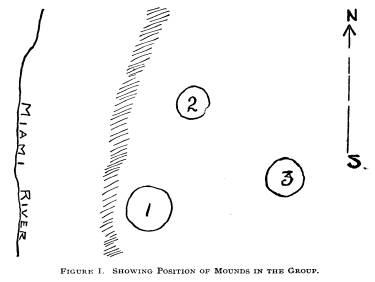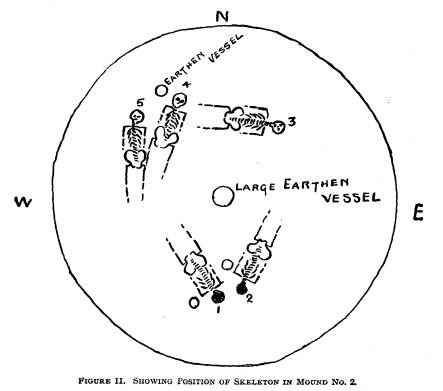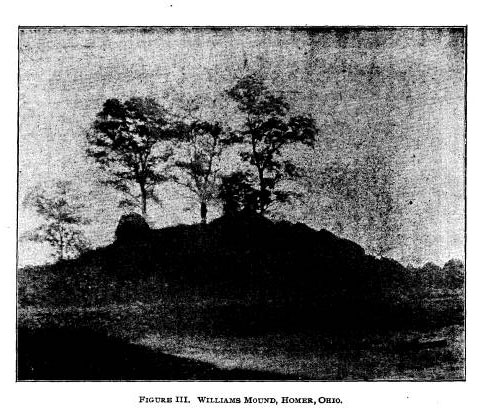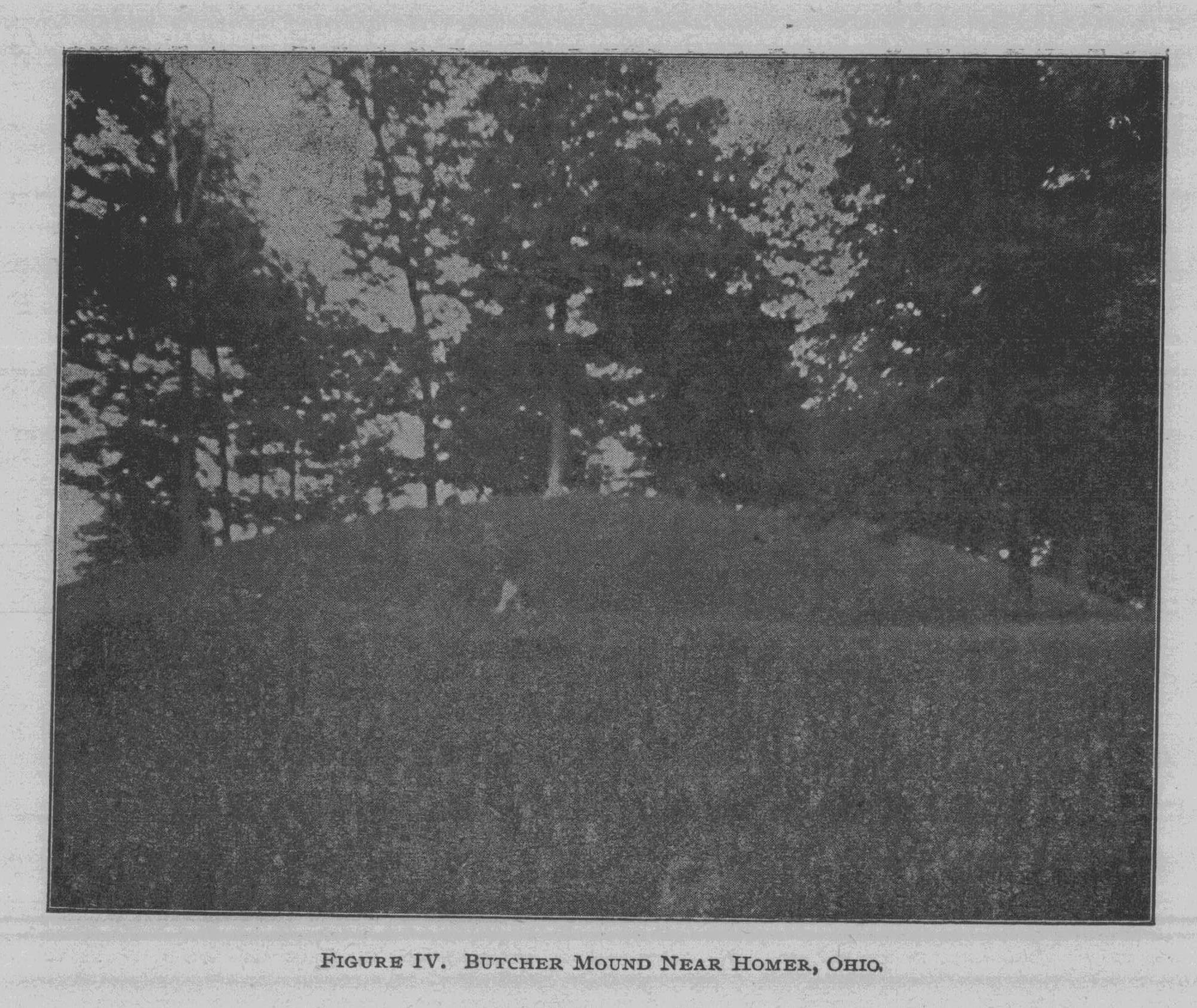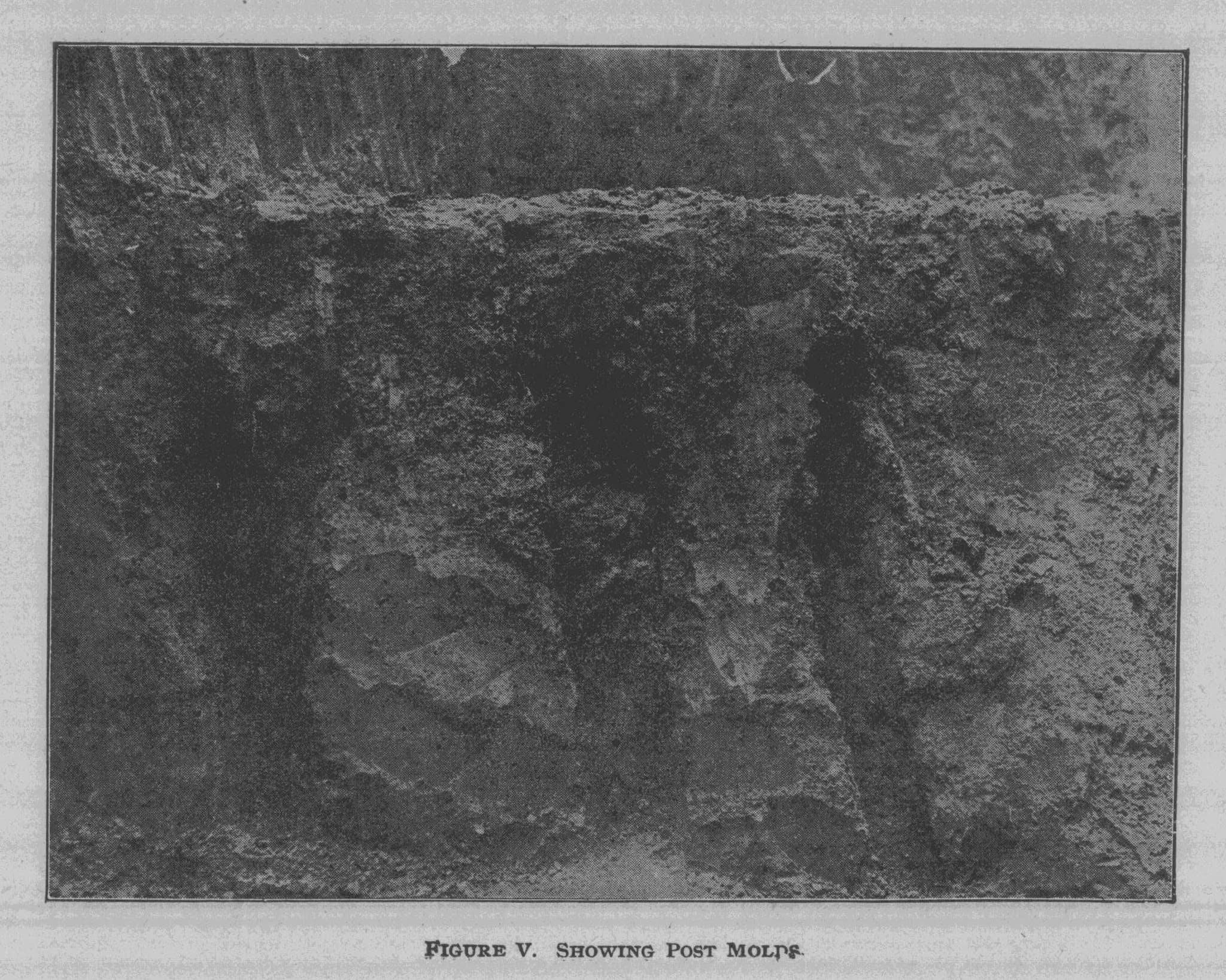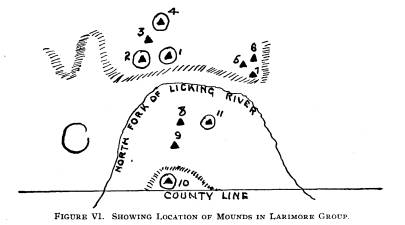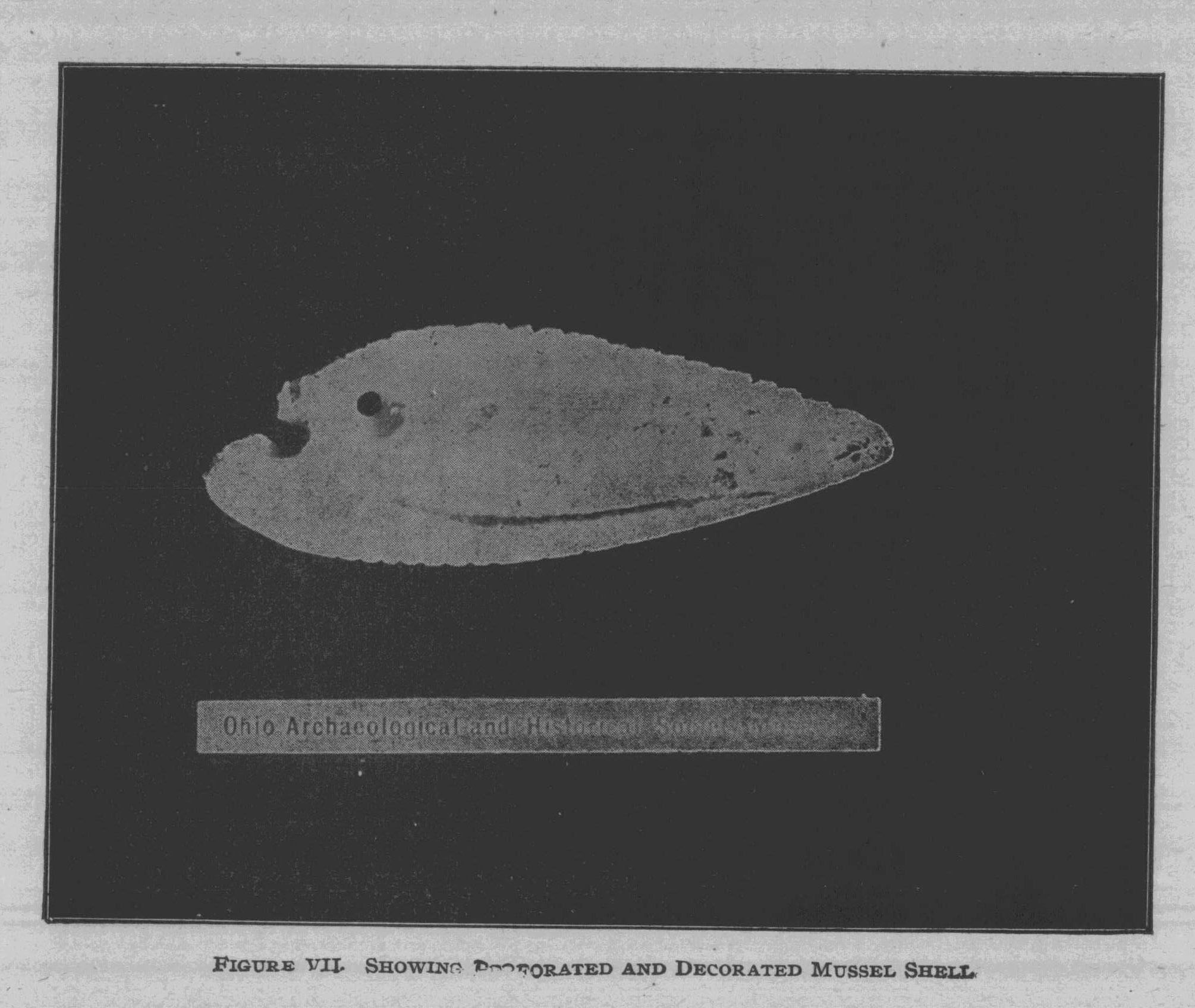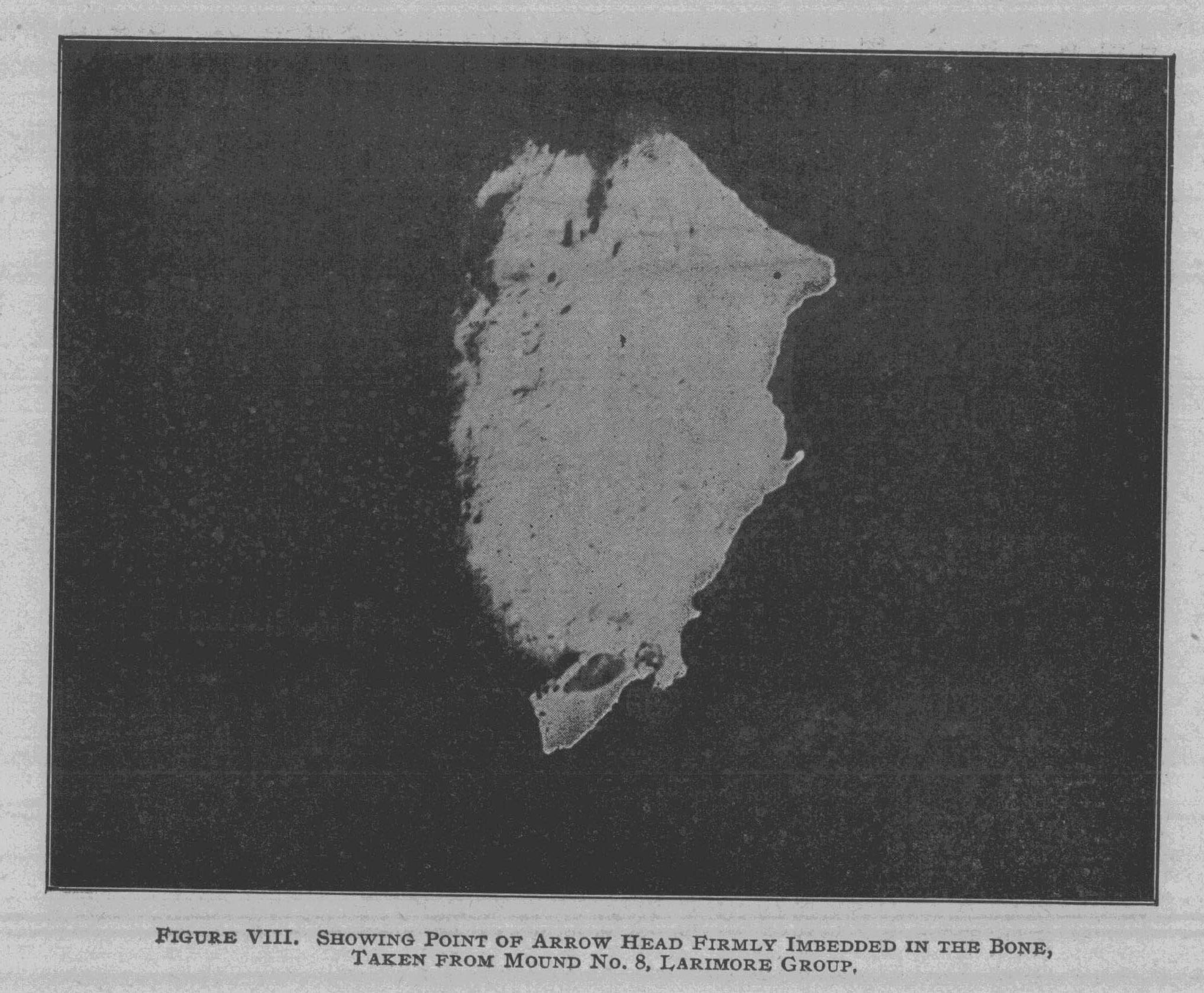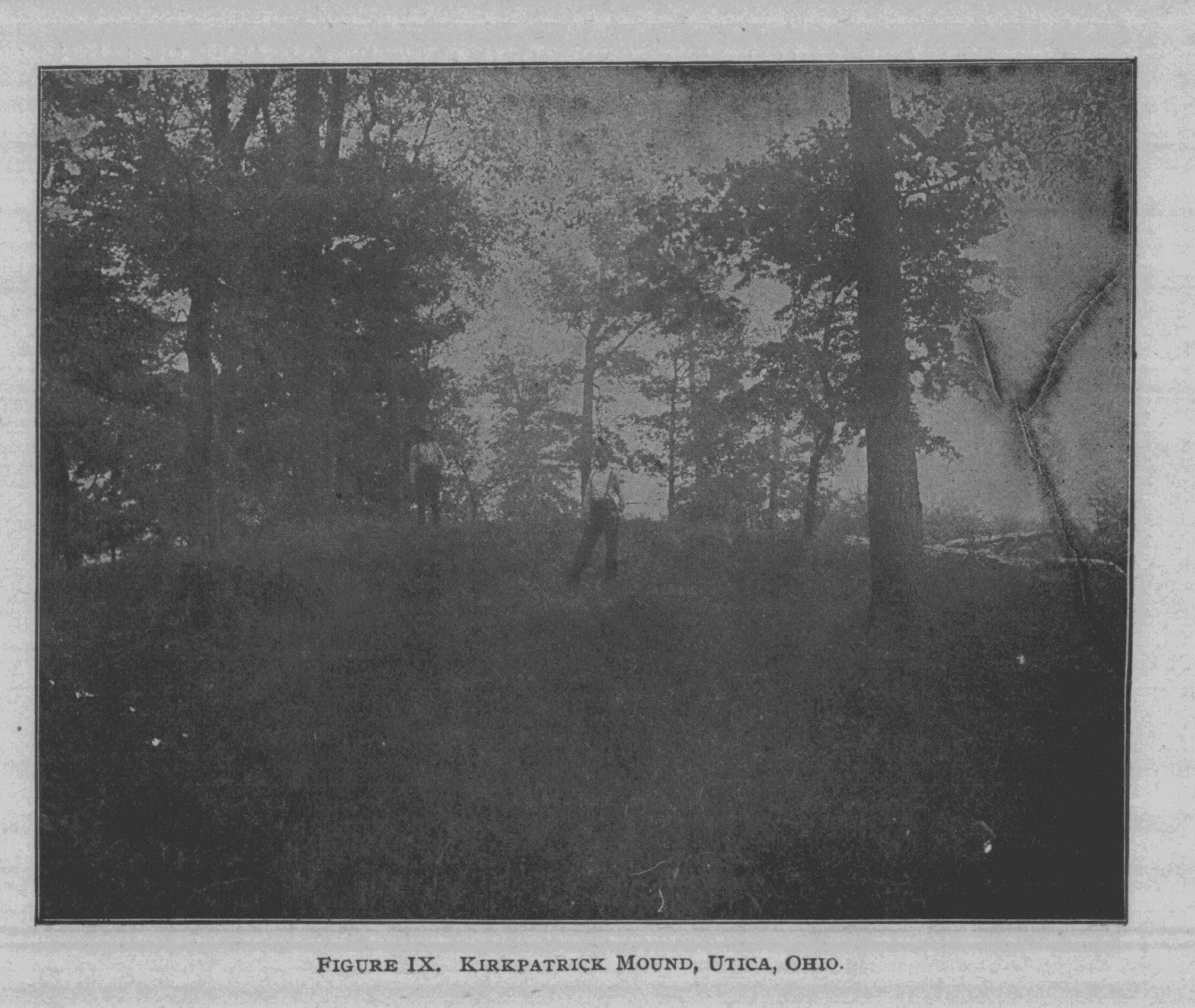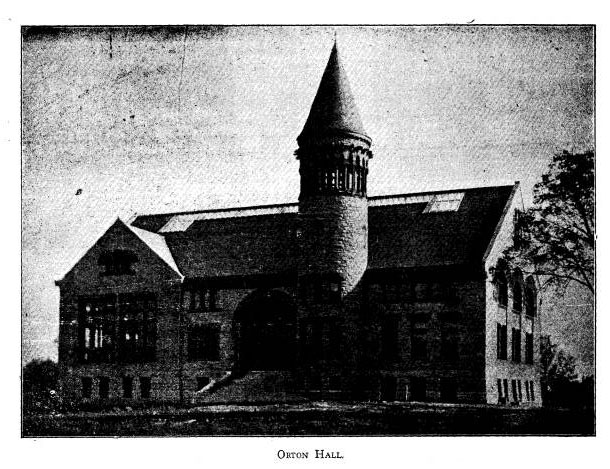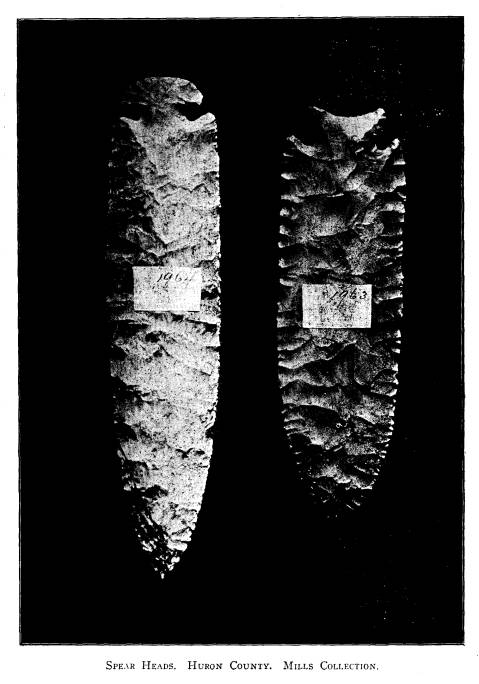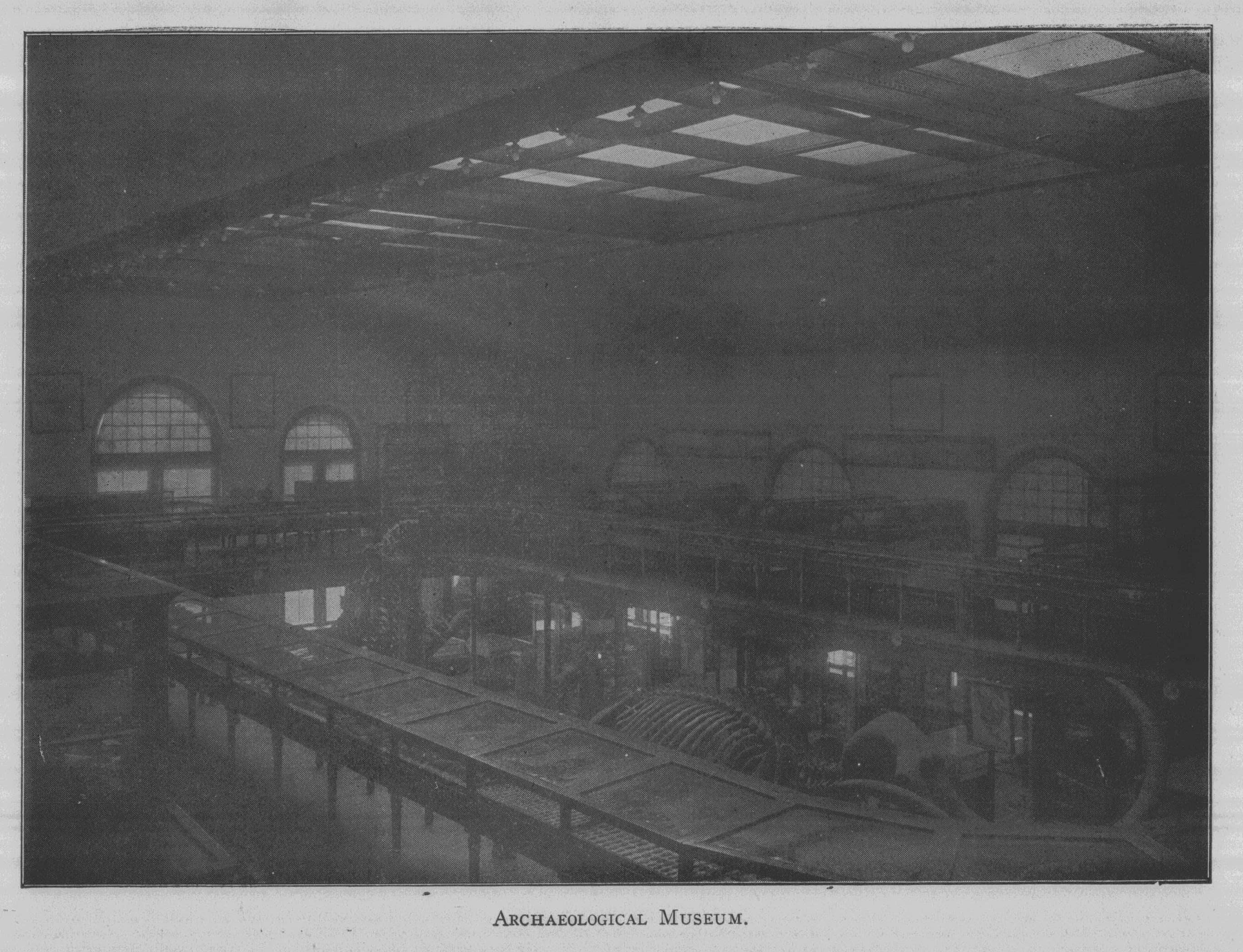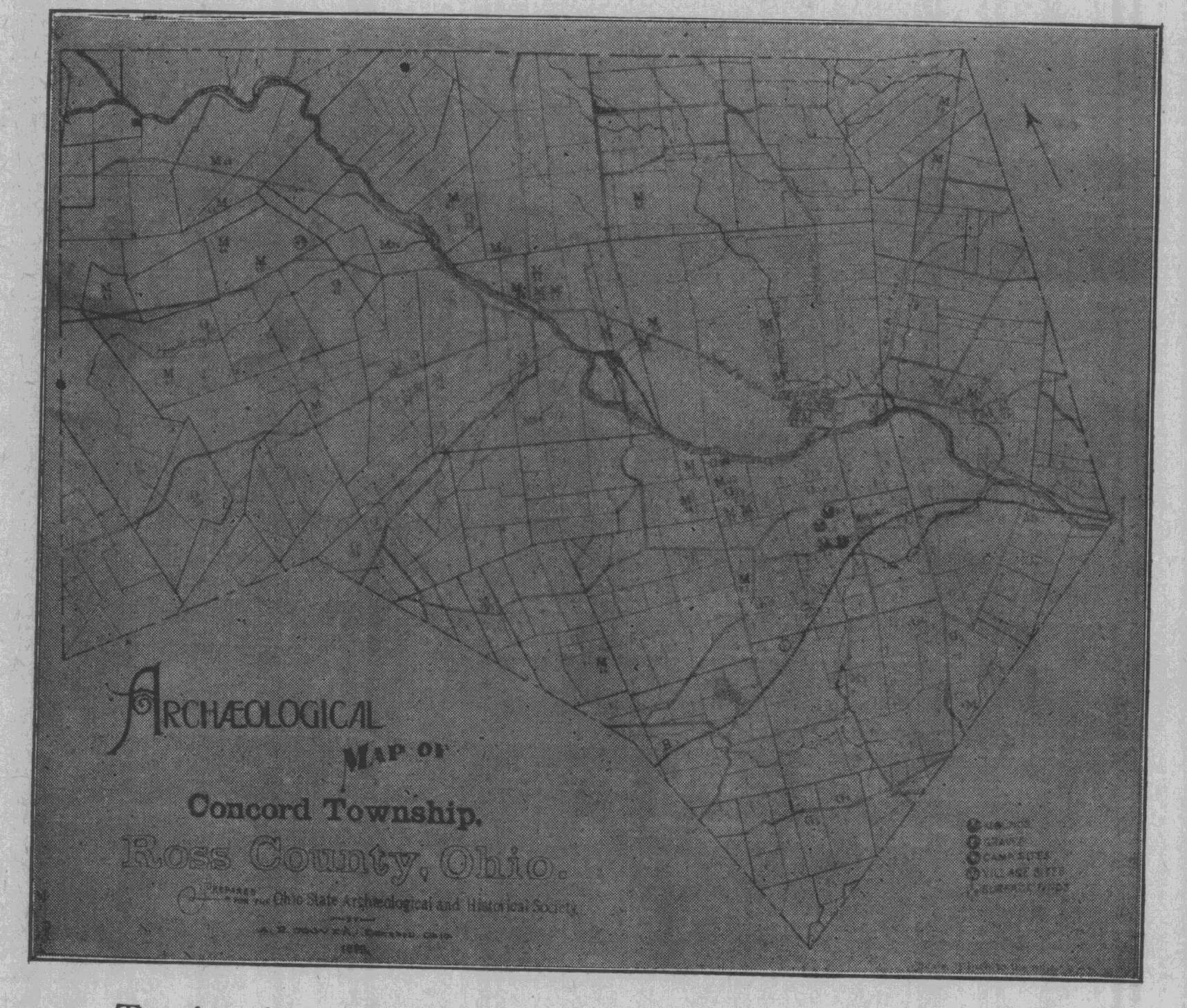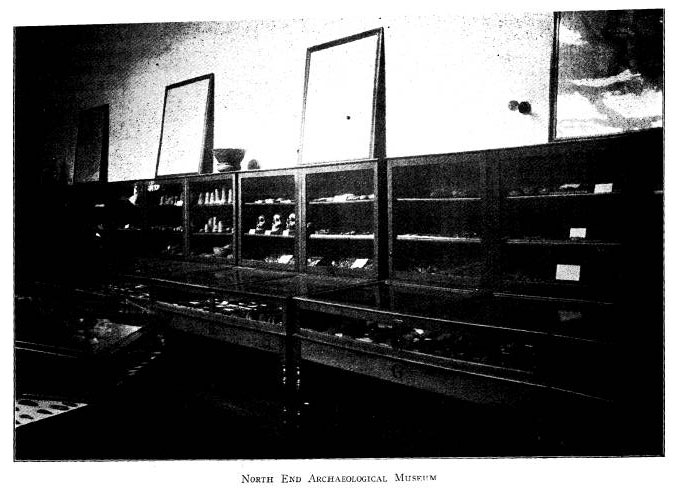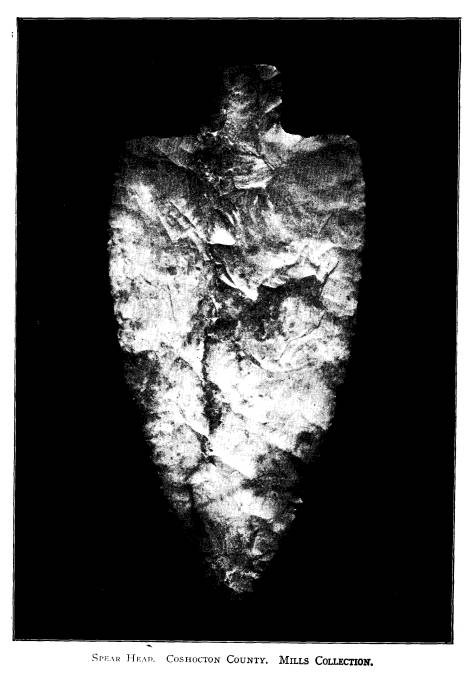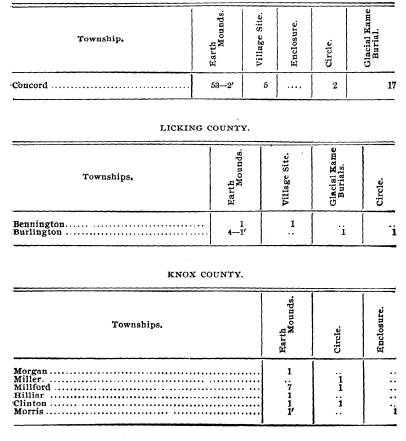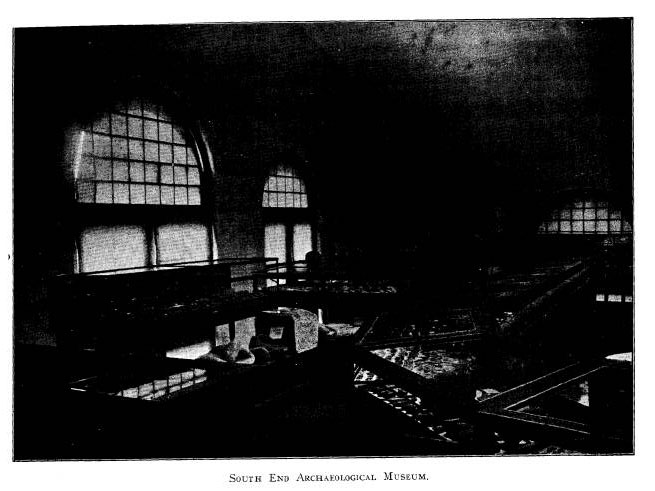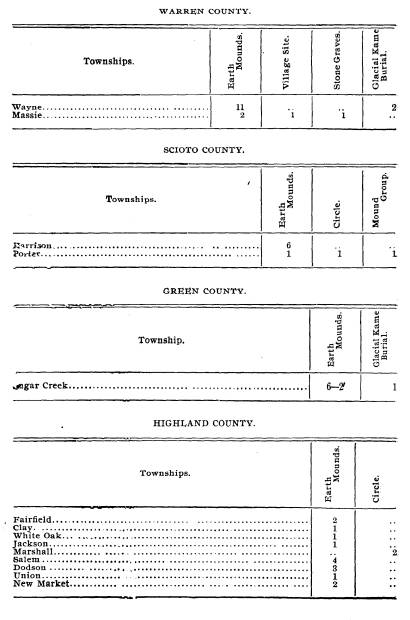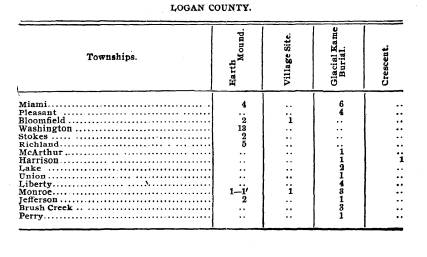Ohio History Journal
- 1
- 2
- 3
- 4
- 5
- 6
- 7
- 8
- 9
- 10
- 11
- 12
- 13
- 14
- 15
- 16
- 17
- 18
- 19
- 20
- 21
- 22
- 23
- 24
- 25
- 26
- 27
- 28
- 29
- 30
- 31
- 32
- 33
- 34
- 35
- 36
REPORT OF FIELD WORK.
BY W. C. MILLS, CURATOR.
PREFACE.
It is the purpose of the Ohio State
Archaeological and His-
torical Society to visit different
sections of the State each year
for explorations upon the mounds and
village sites.
It is apparent to all that the mounds
and earthworks are fast
being leveled by the encroachment of
agriculture and the relic
hunter, who, under the stimulus of
commercial enterprise, tears
the mounds down and forever blots out
evidence which would
materially aid in the solution of many
of the problems which
confront the archaeologist of today.
Consequently opportunities
for securing a more definite insight
into the character and meth-
ods of mound building are rapidly being
destroyed. We com-
menced the field work in Logan County,
but were unfortunate
in getting permission to explore but two
(2) mounds; these were
situated along the Miami River, in
Washington Township. Al-
though we added thirty (30) mounds, one
(1) earthwork and
twenty-seven (27) gravel burials to the
archaeological map. In
the eastern half of the county,
especially in the Mad River Val-
ley, are to be found a great many gravel
kames. In some places
they were formed into beautiful rounded
mounds which are
very often mistaken for works of the
Mound Builders. After
leaving Logan County we examined the
mounds found along
the north fork of the Licking River,
which runs near the boundary
line of Knox and Licking Counties. The
most important of the
mounds examined were the large Butcher
mound, situated in
Burlington Township, Licking County, and
the Larimore group
in Milford Township, southwestern Knox
County. The peculiar
features of the mounds of this group
were the burials at the
center, which were usually beneath the
original surface at a
depth varying from six inches, to five
and one half feet.
I wish to acknowledge the many favors
shown us, while in
the field. Although in a few instances
permission to explore
(309)
310 Ohio Arch. and His. Society
Publications.
mounds was refused, such refusal was
usually based on valid
reasons. In all portions of the country
which we visited, we
were kindly received, and the people as
a rule have a deep interest
in the work, and always shore a
commendable desire to encour-
age us and give us all the information
in their power.
I am especially indebted to Dr. Wanzer,
of Zanesville; Mr.
Harry Evans and Mr. F. N. Draper, of
West Liberty; Mr. M. E.
Burdett, of DeGraff; Dr. J. W. Buxton,
Mr. W. C Butcher, Mr.
Benjamin Quick, of Homer; Mr. Howard
Kirkpatrick and Mr.
W. P. Parks, of Utica; Messrs. Joseph
and James Larimore, and
Frank Sutton, of Lock, Knox County, for
valuable assistance,
suggestions and donations of relics.
To my assistants in the field, Mr. A. G.
Abbott, Medina;
Mr. S. T. Orton, Columbus, and Mr. V. H.
Davis, Byesville, I
extend thanks for the faithfulness and
earnestness with which
they performed their work.
PART I.
MOUND EXPLORATIONS IN LOGAN
COUNTY.
On the east side of the Miami River, on
the farm of Mrs.
Longbreak, two miles north of
Logansville, in Washington
Township, Logan County, Ohio, is a group
of three (3) small
mounds ,situated upon a level plateau
fifteen feet above the bed
of the river and 300 yards from its
banks.
Mound No. 1 (See Fig. 1.) is the largest
of the three mounds
and situated near the edge of the hill
which slopes gradually to
the water's edge. It is 38 feet in
diameter and four feet seven and
one-half inches high.
The surface of the mound has been under
cultivation a num-
ber of years, and its height had been
evidently reduced several
feet. We commenced work on the east side
of the mound at the
base line and explored the entire mound.
The first evidence
of a burial was found six feet from the
starting point and at the
bottom of the mound. The remains were
small pieces of the skull
and large bones. Toward the center of
the mound were found
great quantities of charcoal, covering
an area of about thirty-six
square feet. Nothing was found buried
with this charcoal. At
|
Report of Field Work. 311
the center of the mound were ashes, burned clay and charcoal, intermingled with these were flint chips. Seven (7) feet to the west of the center we found the second skeleton, like the first, only small portions of the large bones |
|
|
|
were found and they were so badly decayed that removal was impossible. The mound was made entirely of clay, with here and there small quantities of dark earth, evidently brought from the bed of the river.
MOUND NUMBER TWO Of this group lies 300 yards north of mound No. 1, and is twenty- five feet in diameter and two and one-half feet high. On the south side of the mound and four feet from the center a skeleton was found buried face down, head to the south and feet extended to the northwest. Near the head were found the remains of a coarse, roughly made earthen vessel. Ten (10) inches directly east of the head of this skeleton was found the head of another skeleton No. 2, also buried face down, feet extended northeast. With this skeleton was also buried a roughly made piece of pot- |
|
312 Ohio Arch. and His. Society Publications. tery, only parts of which could be removed, these parts showed a thickness of one-half inch, made of clay and small round quartz pebbles. The vessel was placed between the skeletons, but nearer skeleton No. 2. With this skeleton was also found a few flint flakes used as knives and a small quantity of charcoal. Directly in the center of the mound and placed on a pile of ashes and charcoal, were the remains of a large earthen vessel of the same pattern and material as the other two (2) described, but twice the size. Within this vessel was a quantity of red ochre, a few flint flakes and a small scraper. North of the center of the mound, three and one-half feet, was found skeleton No. 3, lying east and west. The bones of this skeleton were quite large in proportion to the other skeletons found in the mound, but were in a very bad |
|
|
Report of Field Work. 313
state of decay. With the skeleton was a
small quantity of red
ochre and several flint flakes used as
knives. Near the feet of
No. 3, and to the westward a few inches,
was found skeleton No.
4, head to the north and feet extended
to the southwest. Near
the head was found another earthen
vessel, similar in size to those
found with skeletons Nos. 1 and 2. This vessel contained a small
amount of red ochre. With this skeleton
was also found a large
incisor tooth of a beaver, which had
been worn as an orna-
ment; a few flint knives were also
found. Fifteen inches west of
skeleton No. 4 was found the fifth
skeleton, with head to the north
and feet to the south. Beneath this
skeleton was a small amount
of charcoal and ashes, with a few flint
chips at the feet. All of
the skeletons were those of adults, and
were in a bad state of
decay, and only a portion of each
skeleton was saved. The mound
was made entirely of clay with charcoal
and ashes at the bottom.
The third mound of this group, situated
about 300 yards
from mound No. 2, and about the same
distance from mound No.
1, was not opened. The field was planted in corn and permis-
sion to explore could not be obtained
from the tenant. On the
farm of Mr. Young, which joins that of
Mrs. Longbreak, is a large
gravel terrace, from which a number of
skeletons were taken
while gravel was being hauled for the
roads. Mr. Young kindly
gave us permission to examine the ground
around the pit, and
we were fortunate enough to find the
remains of three (3) skele-
tons. No implements or ornaments were
placed with them, al-
though Mr. Young discovered a few
ornaments buried with skele-
tons previously found, which would
indicate a Shawnee or Seneca
burial.
FIELD WORK IN KNOX AND LICKING COUNTIES.
Along the north fork of the Licking
River are a number of
mounds situated in the valley and upon
the low rolling hills lo-
cated on each side of the river. Among
the most important is the
Williams Mound, situated in the village
of Homer. This mound
is sixteen feet high and 1OO feet in
diameter at the base. Fig.
No. 3 shows the mound at the present
time.
The large Butcher Mound, which is
located "up the river"
from Homer two miles, upon the farm of
Mr. W. C. Butcher, has
Report of Field Work. 315
never been disturbed by the plow, being
situated in a beautiful
grove of sugar maple about 500 yards
from the river, upon a level
plateau, fifteen feet above the river
bed. On the north side of
the mound is a large walnut stump, three
feet nine inches in
diameter. Large sugar trees are growing
upon the mound, the
largest being 18 inches in diameter. The
top of the mound is
perfectly flat, forming a platform
having an area of more than
1,600 square feet. The mound is thirteen
feet high and 135 feet
in diameter north and south, and 126
feet in diameter east and
west.
A large trench was started ten feet
beyond the center to the
south and extended north to the edge of
the mound. This trench
was ten feet wide. When down two feet we
came to a layer of
burned earth, charcoal and ashes about
one-half inch thick. This
extended over the entire mound. At the
depth of five feet an-
other layer, three-fourths inch thick,
of burned earth, charcoal and
ashes was found. In this layer large
qauntities of flint chips and
flakes were also found. A great many of
the flakes were evi-
dently used as knives. At a depth of
seven feet another layer of
ashes and charcoal was found. This layer
was very thin, not
quite one-fourth of an inch in
thickness. Just beneath this thin
layer the soil was slightly colored as
if from the decay of wood or
some other vegetable matter, and varied
in thickness from one
(1) inch to six (6) inches. At a depth of nine feet a great fire
pit was found. This pit was at the
center of the mound and was
six feet in diameter and fourteen inches
deep at the center, and
filled with ashes intermingled with
which, were flakes of flint, flint
knives, calcined human bones and pottery
sherds. The ground
surrounding the fire pit was of yellow
clay, with the appearance
of having been puddled and firmly
packed. Over this floor was a
very heavy layer of ashes with here and
there great quantities of
charcoal. About ten feet from the edge
of the fire pit, we came to
the charred remains of upright posts, as
was evidenced by the
preserved charred post tops, beneath
which were upright vacant
earth molds, made by the charred
posts. (Figure V.)
These post molds were on an average five
inches in diameter,
equi-distant ten inches, and forming
almost a perfect square,
twenty-seven feet by twenty-seven and
one-fourth feet, thus con-
Report of Field Work. 317
stituting a pre-eminent feature of this
mound. The post molds
outside of the trench were traced by
tunneling, as was the entire
mound. At the northeast corner of the
square, formed by the post
molds, was placed a granite boulder,
which would weigh upwards
of 250 pounds. Another at the southeast
corner would weigh 500
pounds. Directly in the center of the
north side was an opening
three and one-half feet wide, evidently
a door-way, as the com-
pacted clay extended outside of the
enclosure. The upright post
molds representing the ends and sides of
this enclosure, would
average three feet in height on the
north side, and two feet and
three inches on the south side, and two
feet and six inches for the
ends. The entire part of the mound
enclosed by the post molds,
was carefully examined but only here and
there a flint chip or a
large flint flake, used as a knife, was
found. The same general
appearance of the soil was noted outside
of this enclosure. On
each side of the great trench, tunnels
were dug into the mound.
Some of these tunnels were ten feet
long, others twenty, and one
forty feet long. No evidence of a burial
was met in the mound.
But on the north side near the base,
there had been evidently
an intrusive burial. The skeleton, that
of an adult, was buried one,
foot below the surface and was covered
with ninety-six small
granite boulders averaging five inches
in diameter. The skeleton
was badly decayed and only a few pieces
of ribs and vertebrae
could be saved. The evidence obtained
from the exploration of
this mound is sufficient to justify the
conclusion that the mound
was built for burial purposes, and in
some religious ceremony the
body or bodies were cremated in the
large fire pit within the en-
closure made by the post molds.
QUICK MOUND.
This mound is located on the farm of
Benjamin Quick, about
three-fourths of a mile south of the
Butcher Mound, and upon
one of the low rolling hills on the
opposite side of the river. The
surface of the mound has been under
cultivation for a number of
years, and consequently it is several
feet lower now than when
the surface was first cleared of the
original forest growth. The
diameter of the mound, when work was
commenced upon it, was
Report of Field Work. 319
forty feet and the height three
feet. A large trench eight feet wide
was dug through the mound. This trench
was enlarged at the
center to twelve feet. A quantity of
charcoal and ashes was
found two (2) feet from the surface,
extending over the entire
mound. Intermingled with the ashes were
a few flint knives and
a beautiful arrow head of red and white
jasper. Near the bottom
of the mound was found a thin streak
(one-fourth inch thick) of
burned clay and ashes, with here and
there small quantities of
charcoal. Near the center in a quantity
of charcoal was found
three arrow heads. One of these was made
of black flint, one and
one-half inches long, and the other two
were made of chalcedony,
averaging one and one-fourth inches in
length. With the arrow
heads was also found a beautiful flint
drill, three inches in length,
made of light flint having a tinge of
red. No trace of a burial
could be found.
THE LARIMORE GROUP OF MOUNDS
Is situated two and one-half miles up
the north fork of the Lick-
ing River from the Butcher Mound, in
Milford Township, Knox
County, and about one mile east of the
postoffice at Lock. This
group consists of eleven mounds and one
earthwork. Seven
mounds and the earthwork are north of
the river, and four
mounds are south. The river at this
point makes a decided bend
to the north, striking against the
hillsides and forming almost
perpendicular banks forty feet in
height, and then turning in a
southerly direction. On the top of this
high bank are situated the
seven mounds north of the river. (Figure
VI.)
Mound No. 1 is thirty (30) feet in
diameter at the base and
two feet high and is placed within an
enclosure or circular em-
bankment one hundred (100) feet in
diameter with a base of eight
(8) feet and one foot high. The mound
was explored a few
years ago by the Larimore Brothers and a
skeleton and a few
flint arrow heads were found. To the
west of this circular em-
bankment is another mound, No. 2, with a
circular embankment
surrounding the mound. This circular
embankment is similar in
every respect to that of mound No. 1,
except that the area en-
closed is larger, being 102 feet in
diameter, while the base of this
|
320 Ohio Arch. and His. Society Publications.
circular embankment is eight feet wide and its height twenty inches. This circle surrounds a mound forty (40) feet in diameter and three feet seven inches high. To one standing a short dis- tance away and viewing the mound it resembles an upturned wash basin. Commencing at the base on the south side of the mound we thoroughly examined its contents. The mound was composed for the most part of a tough yellow clay mottled here and there with a gray sand. Directly east and west of the center, at the base, a quantity of charcoal and ashes and a few flint chips were found. South of the center four (4) feet, and on the base |
|
|
|
line, was found the skeleton of an adult lying at full length, head northeast, feet southwest. The skeleton was surrounded with charcoal and a small quantity of ashes, with which were found a beautiful arrow head of black flint and two (2) flake knives. North of the center three (3) feet was the second skeleton; that of an adult with head to the west. Only a small quantity of char- coal was buried with this skeleton. At the center and below the base of the mound one and one-half (1½) feet, was found the third skeleton, placed in a grave eighteen (18) inches wide and four (4) feet long. With the skeleton, which lay head to the east and feet to the west, were buried a small quantity of char- coal, three (3) flake knives and one arrow head, made of black |
Report of Field Work. 321
flint. Only small portions of the
skeletons could be saved as
they were in a bad state of decay. The
third mound, which is
directly north of mound No. 2,
two hundred and fifty (250) feet, is
on a little higher level than mounds
Nos. 1 and 2. There is a
gradual rise of about ten (10) feet from
the edge of the bluff back
five hundred (500) feet to the top of
the hill. Mound No. 3 was
composed of a yellow clay, mixed more or
less with small bould-
ers. Mr. James Larimore, on whose land
mounds Nos. 1, 2 and 3
are located, informed me that the mound,
when cleared of trees
that were growing upon it, was not less
than five feet high, but
it has been under cultivation for a
number of years and the height
is now three feet with a diameter of
forty (40) feet. Nothing
was found in the mound above the base
line, only at the center,
where a small quantity of burned clay
and charcoal was found.
Below the base line one and one-half
(1½) feet, and directly under
the burned earth and charcoal, was
exhumed the skeleton of an
adult, head to the east and feet placed
as if bent back under the
body, at the time of burial. The size of
the grave was twenty (20)
inches wide and four (4) feet long. The
right arm was placed
across the breast and near the left hand
was found a medium
sized Celt, nicely polished and made of
green dioryte. Near the
Celt and toward the feet was found a
grooved axe, finely polished,
made of granite, the bit being slightly
broken. On the right
side was found a fine, well-wrought
spear-head three and one-
half (31/2) inches long, made of a
yellow, variegated jasper; two
small barbed arrow heads of black flint,
and one of mottled light
and red flint; also six (6) flake knives
averaging two (2) inches
in length. The skeleton was almost
entirely decayed, and no
part of it could be saved.
Mound No. 4 is situated about five
hundred (500) feet from
the edge of the bluff, on the summit of
the hill, upon the land of
Mr. Joe Larimore. This mound in
appearance is much like
mounds Nos. 1 and 2, with a circular
embankment ninety-eight
(98) feet in diameter enclosing the
mound. This embankment
is one foot high with a base of eight
feet. The diameter
of the mound at the base is thirty-five
feet, and height three
feet. On the south side of the mound and
three feet from
the center, on the base line, was found
the skeleton of an adult
Vol VIII-21
322
Ohio Arch. and His. Society Publications.
imbedded in a quantity of charcoal. Near
the left hand was a
perfect arrow head of black flint and
two flake knives. On the
right side and near the head were found
the remains of a large
earthen vessel, roughly made; no
decoration inside or out. The
thickness of the sides and bottom would
average one-half (½)
inch. Within the vessel was a small
quantity of fine chocolate
colored earth, created, no doubht, by
the decay of vegetable mat-
ter. At the center and one foot below
the base line, in a grave
nineteen (19) inches wide and
four (4) feet long, was found an-
other skeleton surrounded with a small
amount of charcoal, ashes
and burnt clay. A few flint chips were
intermingled with the
charcoal.
Mounds Nos. 5, 6 and 7 are situated five
hundred (500) feet
east of mound No. 1, on the point of the
bluff overlooking the
river. Mound No. 5 was one and one-half
(1½) feet high and
fifteen feet in diameter, and was
composed entirely of clay. In
the center and one foot below the base
line, was found a skeleton
so badly decayed that no part of it
could be saved. With the
skeleton was found a perfect arrow head
two (2) inches in length
and made of black flint. Mound No. 6,
situated fifteen (15) feet
east of mound No. 5, was also composed
of clay, and was the
smallest mound of the group, being
fourteen (14) feet in diameter
and twelve (12) inches high. At
the center and on the base line
a few charred bones and a large quantity
of charcoal was found.
Mound No. 7, the last of the mounds of
this group, north of the
river, is situated on the very edge of
the bluff, and was sixteen (16)
feet in diameter and fifteen (15) inches
high. A skeleton was
found six inches below the base line.
With it was exhumed a
quantity of charcoal and ashes. Nothing
was placed with
the skeleton, which was badly decayed,
and no part of it was
saved.
Mound No. 8 is situated on the bottom
land south of the
river upon the farm of Mr. Frank Sutton.
This mound was
nearly leveled by the plow and all
traces of the mound would have
been obliterated in a few years. Mr. Joe
Larimore, who has
lived on the adjoining farm all his
life, located it very easily,
although the ground was covered with a
heavy growth of clover.
The mound originally was about five (5)
feet high, but now it is
Report of Field Work. 323
only thirteen (13) inches in height, and
the diameter forty (40)
feet. The base of the mound was covered
with a light layer of
burned clay, with here and there small
quantities of charcoal.
Near the center was found the skeleton
of a child about ten years
old. The skeleton was fairly well
preserved and was removed
in good condition. At a depth of five
and one-half (51/2) feet below
the base line and in a grave four (4)
feet long, by two and one-
half (21/2) feet wide, were found five
headless skeletons promiscu-
ously thrown together in the grave. With
the skeletons were
found three hundred (300) beads made of
the shell of nerita
rumphia; also thirty (30) large pieces
of perforated and deco-
rated mussel shell. (Figure VII.)
These mussel shells varied in width from
one-half (1/2) to one
and one-half (1½) inches, and in length
from two and one-half
(2½) to five (5) inches. In the grave
were found ten canine
teeth of the fox, perforated at one end
for attachment, and one
canine tooth of a bear, also perforated;
also fifty pieces of turtle
shell, each perforated with two (2) holes. With the skeletons were
found fifteen (15) vertebrae of the
deer, one of these has firmly
imbedded in the bone the point of an
arrow head. Five spear
heads and eleven arrow heads were found
with the skeletons.
One of the bones of the skeleton, that
of an innominatum, had
been pierced by an arrow head, the point
of which was firmly
imbedded in the bone. (Figure VIII.)
The five (5) skeletons taken from this
grave were those of
adults, and the bones were perfectly
preserved even to the small
bones of the hands and feet. This is
readily explained as the
grave extended into the gravel and sand,
which bed formed a
perfect drainage, while in the other
mounds of this group the
burials were in clay soil, and only very
small portions of the
skeletons could be saved. The
conclusions reached by the inves-
tigation of this mound are, that these
skeletons represent braves
slain by their enemies (perhaps in
battle) and that their heads
were carried away as trophies, and their
bodies afterwards gath-
ered together by their friends and
buried in this one grave.
Mound No. 9 is situated four hundred
(400) feet south of
mound No. 8 upon a terrace about five
(5) feet high. This mound
was originally about thirty-eight (38)
feet in diameter and four
Report of Field Work. 325
feet high, but after more than forty
(40) years of cultivation it
has been reduced to one (1) foot in
height. What was left of the
mound was fully explored. On the base
line were found parts
of two skeletons. One was on the north
side of the center and
was surrounded by great quantities of
charcoal. The skeleton
had also been burned and only portions
of the femur and skull
bones could be saved, and they were
badly charred. The other
skeleton was southeast of the center
three (3) feet. This skeleton
had also been burned. With it were found
twenty (20) arrow
heads and spear heads, which had been
nearly destroyed by fire.
The mound was made of yellow clay.
Mound No. 10 is situated three hundred
(300) yards south of
mound No. 9, upon the low rolling hills
which skirt the bottom
land south of the river. This mound
resembled mound No. 1,
in having a circular embankment
surrounding it. Here the plow
had almost obliterated all traces of the
circle, and only enough
remained to permit measurements of it to
be taken. The
diameter of the circle is one hundred
and fifteen (115) feet,
which is larger than any so far recorded
in this group. The
height of the circle is three-fourths
(3/4) of a foot. The mound
was approximately forty-five feet in
diameter and nine (9) inches
high, and composed entirely of yellow
clay. The base line was
shown plainly as it was covered with
ashes and charcoal. Six
(6) inches below the base line was found
the skeleton of an adult
placed in a grave which was four (4)
feet long and twenty (20)
inches wide. No charcoal or ashes
surrounded the skeleton but
the six (6) inches of soil covering the
skeleton contained particles
of charcoal mingled through it. With
this skeleton was found
a fine arrow head of black flint.
Mound No. 11, situated on the bottom
land of the river, two
hundred (200) feet east of mound No. 8,
on the farm of Mr. Joe
Larimore, is the last and largest of the
Larimore group. Mr.
Joe Larimore informed me that when his
father first moved to
this farm the mound was six (6) feet
high and fifty (50) feet in
diameter, and was surrounded by a
circular embankment two (2)
feet high and one hundred and seventy
(170) feet in diameter.
Now the embankment can scarcely be
traced while the mound is
not more than six (6) inches high. We
did not examine it, for Mr.
Report of Field Work. 327
Larimore assured me that forty-five (45)
years ago when the land
was cleared the mound also was leveled
down and everything
removed from it. The mound contained
three skeletons, of which
two (2) were adults. Buried with them
were ornaments of shell
and stone, also arrow and spear heads.
The third skeleton was
that of a child encased in an elongated
earthen vessel which was
accidently broken after it had been
removed.
Directly west of mound No. 8, and across
the river is a large
circular earthwork occupying about three
acres of the fine bot-
tom land which is valuable for
agricultural purposes. Like the
mounds it has been leveled by the plow
and no measurements
could be accurately made. But those who
saw it a half century
ago, say it was not less than five (5)
feet high with a base of twelve
(12)
feet. In some places all traces of it are
gone, but the pass-
age way to the east facing the river is
perfectly discernible.
KIRKPATRICK MOUND.
The Kirkpatrick Mound is situated upon a
hill two hundred
(200)
feet high, overlooking the valley of the
Licking River, on
the farm of Mr. Howard Kirkpatrick, one
mile north of Utica
on the line of Knox County. The mound
was sixty feet in
diameter and three and one-half (3½)
feet high, having large
oak trees growing upon its surface
making it impossible to ex-
amine it on the northwest side. The
remainder of the mound
was thoroughly explored and five
skeletons found, promiscu-
ously buried as to the cardinal points.
The mound was made
of yellow clay and covered with several
layers of thin slabs of
stone. On the south side a skeleton was
found, head to the
northeast and feet extended to the
southwest. Nothing was
found with this skeleton except a small
amount of charcoal. At
the center was found a grave four and
one-half (41/2) feet long
by eighteen (18) inches wide, made of
small slabs of stone with
a covering of large wide slabs. In this
grave was the skeleton of
an adult. Buried with this skeleton were
the remains of an
earthen vessel, which had been broken by
the falling of one of
the top slabs. The skull was also
crushed in the same way, as
the slab was lying directly over the
skull and the jar. A number
Report of Field Work. 329
of ornaments made of mussel shell and
resembling those found
in mound No. 8, of the Larimore Group
(Fig. 7), and two finely
wrought arrow heads of yellow jasper
were found. Another
skeleton was unearthed three feet north
of the center. With the
latter skeleton was found a small amount
of charcoal. East of
the center three and one-half feet was
found the fourth skeleton.
Nothing was found with this skeleton.
Southeast, four feet, was
found the fifth skeleton. With this were
discovered a few flint
flakes used as knives, a small black
flint arrow head and a very
small quantity of charcoal. The
skeletons were all in an ad-
vanced stage of decay and only small
portions of each could
be saved.
PART II.
REPORT OHIO STATE ARCHAEOLOGICAL AND
HISTORICAL
SOCIETY MUSEUM FOR YEAR ENDING MAY 31,
1899.
Before entering upon a detailed
statement of the condition of
the Museum for the period covered by
this report, it would per-
haps be well to recall briefly the
outline of its history and origin.
In 1875 about fifty persons, interested
in archaeology, met
at the home of General R. Brinkerhoff,
of Mansfield, and formed
a society known as the "Ohio
Archaeological Association," and
the following year this Association was
called upon to take part
in the Centennial Exposition held in
Philadelphia. Professor M.
C. Read, of Hudson; Colonel Chas.
Whitelsey, of Cleveland, and
Judge Sloane, of Ottawa, were appointed
a special committee,
to collect relics of the races prior to
our own, and forward them
to Philadelphia. It was also their duty
to arrange them for
exhibition, and at the close of the
Exposition to return them
to the Society, or to their owners.
Although the committee had only about
two months to col-
lect together the relics and forward
them to Philadelphia, they
made a very creditable display, ranking
next to that of the Smith-
sonian in interest and value. At the
close of the Exposition a
great many relics were donated to the
Ohio Society. Quarters
were secured for the Society's
collection in the State House,
and Mr. J. H. Klippart was elected
custodian. The collection
330 Ohio Arch. and
His. Society Publications.
was increased by donations from citizens
from various parts of
the State. But the Society became
inactive and all interest in
augmenting the collection was lost. In
February, 1885, Mr. A.
A. Graham, of Columbus, after
consultation with many friends
of the old society, called a preliminary
conference, which was
held in Columbus, to take steps towards
the organization of a
State Archaeological and Historical
Society. As a result of this
conference, a committee was appointed to
draft and issue a call for
a State Convention to be held in the
State Capitol, in the City of
Columbus, March 12, 1885. At this
meeting articles of incor-
poration and by-laws were adopted, and
Hon. Allen G. Thurman
was elected President.
Article No. 3 bears directly upon the
Museum of the re-
organized society, which is as follows:
"Article No. 3-Said Society is
formed for the purpose of
promoting a knowledge of Archaeology and
History, especially
in Ohio, by establishing and maintaining
a library of books,
manuscripts, maps, charts, etc.,
properly pertaining thereto; a
museum of pre-historic relics and
natural or other curiosities or
specimens of art or nature promotive of
the objects of the Asso-
ciation. Said library and museum to be
open to the public on
reasonable terms-and by courses of
lectures and publication
of books, papers and documents touching
the subjects so speci-
fied, with power to receive and hold
gifts and devices of real and
personal estate for the benefit of such
society, and generally to ex-
ercise all the powers legally and
properly pertaining thereto."
The first public meeting of the Society
was held in the
Senate chamber on the evening of the
same day that the Society
was formed, and was addressed by General
R. Brinkerhoff.
In his address he stated that one of the
objects of the
old Archaeological Society was the
"preservation of the relics of
Ohio. We have permitted the earthworks,
mounds and graves
to be despoiled by the whole world. The
ornaments, utensils
and implements are of such value that
Ohio is the spoil of all
nations and many of the best relics have
already been carried
away. There are better collections of
ancient relics of Ohio in
London and Paris than in the
State." This speech of General
Brinkerhoff aroused much interest in the
preservation of Ohio
Report of Field Work. 331
332 Ohio Arch. and His.
Society Publications.
more. Specimens to be of the highest
service to the second
class of visitors must be arranged in
series showing the var-
ious phases of some one subject or the
modification of various
types found in the different sections of
the State.
Third, the sight-seeing visitors who
make quite different de-
mands. They visit the Museum from an
intelligent curiosity to
see the master pieces of art wrought in
stone, shell and bone,
which illustrate in the most striking
manner the history and
progress of a civilization which at one
time inhabited our State.
They also demand that the collection
shall be provided with labels
and arranged in a very attractive
manner.
At the beginning of the year 1899, the
total number of
specimens catalogued belonging to the
Society were 18,678. Dur-
ing the year 3,560 specimens have been
numbered and entered
upon the catalogue. The Skinner
collection, which was placed in
the Museum on loan, and consisted of 389
specimens, was with-
drawn from the Museum, having been sold
by the owner, Miss
Maggie Skinner, of Kalida, Ohio, to the
Field Columbian
Museum, of Chicago, Ill., which leaves
the total number of re-
corded specimens in the Museum at
21,849. (May 31, 1899.)
I am very much gratified at the
increased interest in archaeo-
logical and historical matters
throughout the State.
During the year 312 letters and 18
packages containing
specimens for identification have been
received. All letters have
been answered and a press copy made.
REVIEW OF THE MOST IMPORTANT ACCESSIONS.
The following are the most important
additions to the col-
lection during the year:
Frank N. Beebe, Columbus, Ohio,
presented camas root
digger from Priest's Rapids, Columbia
River.
Mr. T. S. Cleveland, Calais, Monroe
County, Ohio, a large
spinning wheel made in 1844.
Mr. C. G. Knight presented two sections
showing the ends
of the early strap rail laid on the old
Mad River and Lake Erie
R. R., now Sandusky Division of the C.,
C., C. & S. L. R. R.
This rail was laid about the year 1838.
Report of Field Work. 333
334
Ohio Arch. and His. Society Publications.
the Baum Village site and vicinity, and
each specimen is accom-
panied with full and complete data.
Mr. B. B. Herrick, of Wellington, Ohio,
gave a copy of
Dr. Watt's Lyric Poems, printed in 1798.
From Mr. James Parke Harris was received
a piece of a
Spanish battle flag, captured at the
battle of El Caney, Cuba.
Mr. Frank Larimore presented grooved
axes, celts, arrow
and spear points found near the mounds
upon his farm.
Mr. W. P. Parks, of Utica, Ohio, gave a
very fine roller pestle
163/4 inches long and a finely finished
spear head 51/4 inches long.
Mr. M. E. Burdett, De Graff, Ohio,
presented a finely
made grooved hammer.
Mr. Perry Wolfe, Fort Ancient, Ohio,
presented a worked
piece of cannel coal, found inside the
walls, of Fort Ancient.
Mr. M. A. Honline, Columbus, Ohio,
donated a small col-
lection, taken from a mound in New
Market Township, Highland
County, consisting of arrow and spear
heads, stone tablets, pipe,
worked jaw bone of an animal, pieces of
mica, gorgets and
human bones.
Mr. William Stoneman, Fort Ancient,
Ohio, presented a
large worked piece of galenite found
inside the walls of Fort
Ancient.
From Mr. H. E. Thrailkill, Columbus,
Ohio, was received
an addition to his large collection,
already in the Museum, con-
sisting of grooved axes, celts,
ceremonials, arrow and spear
heads; all from Franklin County, Ohio.
From Mr. Nat S. Green, Camp Dennison,
Ohio, was re-
ceived a small collection of stone
relics and a few historical speci-
mens of great interest.
Mr. C. G. Knight, Columbus, Ohio,
deposited in the
Museum a collection of grooved axes,
celts, pestles, ornaments,
arrow and spearheads.
The Rev. Henry J. Van Vleck, Senior
Bishop of the Mora-
vian Church in America, Gnadenhutten,
Ohio, presented three
relics from the early Moravian Missions
at Gnadenhutten. One
is a section of a floor-board of the
first church at Gnadenhutten,
dedicated in 1803. Another is a
piece of the column which ori-
ginally supported the ceiling of the
second church dedicated in
Report of Field Work. 335
|
336 Ohio Arch. and His. Society Publications. cord Township, Ross Co., and personally visited every farm in the Township and recorded upon the map all earth-works, burials and village sites. He also marked the farms upon which valuable finds have been made. Mr. Coover has kindly donated his map together with his re- port, which is given in full. |
|
|
|
Tracing is made from an Atlas of Ross County, printed in 1875 by H. T. Gould & Co. Mounds, graves, and camp sites were visited, personally, and located as nearly as possible in their proper position on each farm. The surface finds were reported by the owners. No. 1.-A gravel pit on the farm of C. F. Defeu from which several skeletons have been taken. No. 2.-A gravel pit on the farm of Peter Porter, in which several skeletons have been found. No. 3.-A small mound on the farm of A. P. Craig. Size |
Report of Field
Work. 337
4x40 ft. Opened by A. B. Coover,
containing an intrusive burial
at the top. Charcoal and ashes at the
bottom.
No. 4.-A small mound 3x30 ft. on the
farm of R. D. Robert-
son. It is in a ravine and built of
stone covered with soil.
No. 5.-Grave on the farm of Alex Pearis.
Skeleton found
while digging cistern.
No. 6.-A camp site on the farm of R. D.
Robertson. Spe-
cimens of stone, flint and slate have
frequently been ploughed
up, also fragments of pottery.
No. 7.-A gravel pit on the farm of A. R.
Darby, in which
skeletons have been found.
No. 8.-A small mound 2x40 ft. on the
farm of Mrs. Jones.
No. 9.-A small camp site on the farm of
H. H. Pratt
No. 10.-A small mound on the farm of
Ashford Roseboom,
located in the woods at the foot of a
hill.
No. 11.-A gravel pit on the farm of Amos
Fisher, in which
skeletons have been found.
No. 12.-A small mound on the farm of
George Fisher,
opened several years ago by S. A. Hanna
of Greenfield, 0., con-
tained nothing of interest.
No. 13.-A gravel pit on the
farm of Abner Thomas, in which
one skeleton was found.
No. 14.-A small mound 3x4o
ft. on the farm of Miss Dorcas
Dunlap, opened several years ago by W.
K. Moorehead.
No. 15.-A small mound 4x40 ft. on the
farm of Miss Susie
Pancake. Has been partially explored.
No. 16.-A fine mound 12x70 ft. on the farm
of Miss Dorcas
Dunlap. From its location and
surroundings would judge it to
be one of the best mounds in the
Township.
No. 17.-A small mound 3x20 ft. on the farm
of Miss Dorcas
Dunlap. Opened several years ago by W.
K. Moorehead, but
contained nothing of interest.
No. 18.-A gravel pit on the farm of Dr.
A. M. Galbraith,
in which skeletons have been found.
No. 19.-A village site on the
farm of Dr. A. M. Galbraith,
and is a continuation of the gravel
ridge, No. 18. Stone bowls,
pottery, copper, etc., have been
ploughed up.
Vol. VIII-22
338 Ohio Arch.
and His. Society Publications.
No. 20.-A small, low mound 3x30 ft. on
the farm of W. Pan-
cake.
No. 21.-A small mound 2x20 ft. on the farm of Wm. Pan-
cake, close by No. 20.
No. 22.-Gravel knoll on the farm of
Roseboom & Phillips.
There have been 18 skeletons taken from
this knoll in a space
of 30x50 ft., and others were in sight
when work was discon-
tinued.
No. 23.-Small mound 4x30 ft. on the farm
of Roseboom &
Phillips, close to No. 22. Opened
by W. K. Moorehead.
No. 24.-A small mound 3x30 ft on the
farm of John Hyer.
No. 25.-A camp site on the farm of
Roseboom & Phillips.
Pottery fragments, bone, beads, stone
and flint implements are fre-
quently found here.
No. 26.-A small mound on the farm of
Roseboom & Phillips.
Was opened by some boys several years
ago.
No. 27.-A small mound on the Ed.
Hopkins' farm. It is
in the woods on the top of a large hill.
No. 28.-A small mound 4x30 ft. on the
farm of Mrs. Bush.
No. 29.-Graves on the farm of Mrs. Bush.
Discovered
in digging a cellar
No. 30.-A mound 9x50 ft. on the farm of
Jesse Mallow. A
small hole 4x8 ft. has been dug near the
center.
No. 31.-A mound 10x80 ft. on
the farm of George Hana-
walt, partially explored by W. K.
Moorehead.
No. 32.-A small mound 4x45
ft. on the farm of George
Hanawalt, close by No. 31.
Small hole dug in the center by
W. K. Moorehead.
No. 33.-A small mound 6x40
ft. on the farm of Albert
Coyner. Has been partially explored.
No. 34.-A gravel pit on the
farm of John Coyner, in which
skeletons are frequently found.
No. 35.-A small mound 3x40
ft. on the farm of John Coyner.
Has been opened.
No. 36.-Graves on the farm of Adam
Harper. At this point
the writer dug up a skeleton which had
been placed in a sitting
position. Buried with it were a small
grooved ax and a number
of human bones covered with paint.
Report of Field Work. 339
340 Ohio Arch. and His. Society Publications.
Report of Field Work. 341
No. 71.-A mound 8x60 ft. on the farm of
J. and G. Devine.
No. 72.-A small mound about 4x25 ft. on
the farm of D.
C Anderson.
No. 73.-A mound 8x60 ft. on
the farm of Jacob Miller. Has
been opened.
No. 74.-A mound 2x30 ft. on the farm of
Jacob Miller.
No. 75.-A mound 3x40 ft.
on the farm of Jacob Miller.
Opened by Capt. McGinnis and A. B.
Coover. No specimens.
No. 76.-Village site on the farm of
Thomas Fulton. Never
explored.
No. 77.-A mound 3x30 ft. on the farm of
Mrs. Ida Donald-
son. Never opened.
No. 78.-A mound 4x25 ft. on the farmof
Phillip Putman.
Never opened.
No. 79.-A mound 3x38 ft. about 600 yards
east of mound
No. 3.
No. 80.-A mound 3x32 ft. about 100 yards
northeast of
mound No. 79.
Surface finds are reported on every farm
in the Township.
Chas. Cory has a small collection
consisting of axes, pestles,
celts, arrow points and a fine coffin
shaped ceremonial ornament.
Samuel Maddox has a small collection
consisting of axes and
arrow points.
Thos. Bay has a small collection of
axes, celts, cones and
arrow points.
George Hanawalt has a small collection,
the best speci men
being a fine slate ornament.
Mrs. J. M. Slagle has a small, but
interesting collection of
axes, arrow points, etc.
W. D. Mallow has a fine collection of
mortars, pestles, axes,
slate ornaments, etc.
A. B. Cline has a good collection of
unfinished slate orna-
ments.
The McGinnis collection at Frankfort
contains some 2000
specimens, many of which are rare.
L. M Bean has a collection of about 800
pieces, including a
large number of bone implements.
|
342 Ohio Arch. and His. Society Publications.
A. B. Coover has a collection of about 1800 specimens, of which nearly three hundred were presented to the Society. Dr. A. M. Galbraith has a small, but interesting collection.
SUMMARY OF ADDITIONS TO THE ARCHAEOLOGICAL MAP DURING THE YEAR ENDING MAY 31, 1899, ACCORDING TO TOWNSHIPS.
ROSS COUNTY. |
|
|
|
344 Ohio Arch. and His. Society Publications. |
|
|
REPORT OF FIELD WORK.
BY W. C. MILLS, CURATOR.
PREFACE.
It is the purpose of the Ohio State
Archaeological and His-
torical Society to visit different
sections of the State each year
for explorations upon the mounds and
village sites.
It is apparent to all that the mounds
and earthworks are fast
being leveled by the encroachment of
agriculture and the relic
hunter, who, under the stimulus of
commercial enterprise, tears
the mounds down and forever blots out
evidence which would
materially aid in the solution of many
of the problems which
confront the archaeologist of today.
Consequently opportunities
for securing a more definite insight
into the character and meth-
ods of mound building are rapidly being
destroyed. We com-
menced the field work in Logan County,
but were unfortunate
in getting permission to explore but two
(2) mounds; these were
situated along the Miami River, in
Washington Township. Al-
though we added thirty (30) mounds, one
(1) earthwork and
twenty-seven (27) gravel burials to the
archaeological map. In
the eastern half of the county,
especially in the Mad River Val-
ley, are to be found a great many gravel
kames. In some places
they were formed into beautiful rounded
mounds which are
very often mistaken for works of the
Mound Builders. After
leaving Logan County we examined the
mounds found along
the north fork of the Licking River,
which runs near the boundary
line of Knox and Licking Counties. The
most important of the
mounds examined were the large Butcher
mound, situated in
Burlington Township, Licking County, and
the Larimore group
in Milford Township, southwestern Knox
County. The peculiar
features of the mounds of this group
were the burials at the
center, which were usually beneath the
original surface at a
depth varying from six inches, to five
and one half feet.
I wish to acknowledge the many favors
shown us, while in
the field. Although in a few instances
permission to explore
(309)
(614) 297-2300
